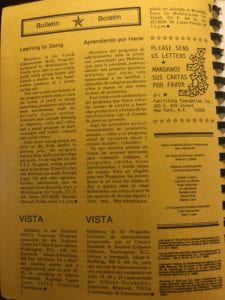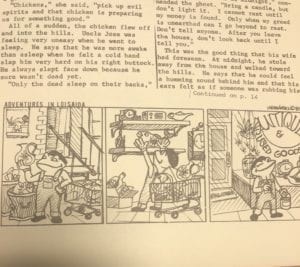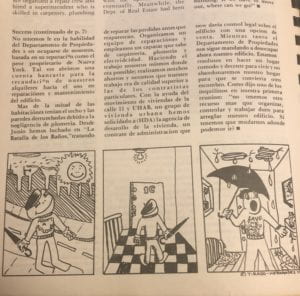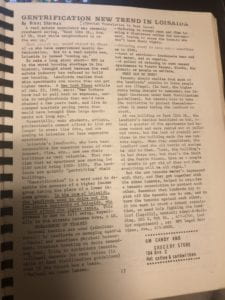My work at the Loisaida Center has consisted on being a part of a number of projects and helping out with events, that has allowed me to learn a great deal about the organization and the community it serves. We are now in the process of creating a reissue of the “Quality of Life in Loisaida” magazine which published several issues, in the late 1970’s and early 1980’s, Mary McCarthy, Alfredo Irizarry, and team. It’s hard to say exactly how many volumes/issues were published since the Loisaida Center does not have a full archive of the Magazine. Nonetheless, the collection that Loisaida has is the document that has been most important for our work. In the past few days, I have been working to put together my part of the magazine. The goal of the project is to pay homage to the original creators. Because of this, the archives that we have are crucial for us.

Example of Bulletin with information about a youth skills training program
The magazine was set up to have a mix of useful and interesting information for the residents of Loisaida. There was always a bulletins and letters section, which had lots of information about things going on in the neighborhood, apartments available, housing issues, and health services. There was usually some element of art, whether it be a short story, poem, or illustration. There was always a comic/cartoon, and then cartoons were particularly interesting because of their relevance and function. Each cartoon was usually about a neighborhood issue, for example, there was one about turning garbage found on the streets into art, and one about homesteading, where the character fixed up an apartment. Often times there was a neighborhood profile, and this is the part I have begun working on for the magazine. Angie Hernandez came in with Chino Garcia, one of the founders of CHARAS community center, and I soon learned that she had moved back to NYC from Puerto Rico after hurricane Maria in November. She had moved there only 5 years ago after retiring, and expected to live the rest of her life there. I will go more in depth in my blog post which will be specifically about this interview.

Cartoon about finding items in garbage and recycling them into use

Cartoon about the “adopt a building” program and the crumbling infrastructure in the Lower East Side
I was told by Chino Garcia that the Quality of Life Magazine was printed in the CHARAS community center during its run. The Community center is now defunct because they were evicted from their building on 9th street between Avenue B and C. The day that Chino and Angie came into the Loisaida Center marked the 2oth anniversary of their eviction. They were there to prepare for a rally outside of the building, where Chino would speak alongside councilwoman Carlina Rivera, Assemblyman Harvey Epstein, and Borough President Gale Brewer. This is the kind of event that might be featured in the magazine. It was a way for people to hear important information as its own community sees it. This is an extremely important part of a community to have access to knowledge and information. Often times news about issues surrounding much larger groups like the whole city or country is what is most accessible to people, but for Loisaida and its strong activist history, it was crucial to spread information and inform the community about issues, because whether or not people know about things could make a huge difference. The magazine was especially important for accessibility because everything was bilingual Spanish and English. If 300 people show up to a rally instead of 30, that’s going to bring attention and could be the difference of a law protecting gardens being passed. Now with the internet, a physical magazine doesn’t hold the same significance because communicating has become so much easier. Nonetheless, our magazine will serve as a way to honor the significance that the magazine played, and may for some be informative and helpful.

Article about gentrification
Bibliographic information:
The Quality of Life in Loisaida = Calidad de Vida en Loisaida, New York, NY, Q-L Publishing foundation, English Spanish, 1978 (first publication)

It’s true that maybe a small zine won’t have the same impact today as it might have 30 years ago, but I also think there’s something compelling and inter-generationally important about reproducing it. Here’s why. For one thing, many of the “old timers” who are in the neighborhood today and struggled to keep Loisaida alive against the onslaught of speculation may remember the original issues. To see that young people are reviving the newsletter reaffirms the struggle and maybe adds a little energy into current efforts. It’s also attractive because so much of our urban experiences now (or just in life) are about sleek packaging, curated and mediated information, splashy visual impact, and what’s on our little screens. There’s something about a home-made and home-grown document that shifts perspective a little bit. And that shift is something we’re asking for in all of our more radical cultural and artistic practices — ultimately, aren’t we in some ways really asking people to slow down, interact with one another without a screen, care for the people and places around them, garden, hold a newsletter in their hands and read?